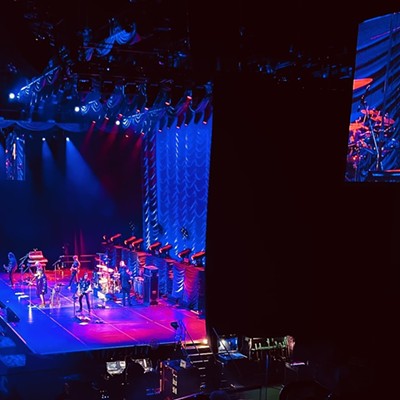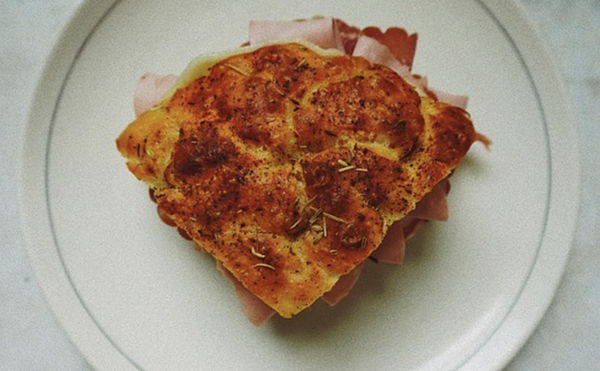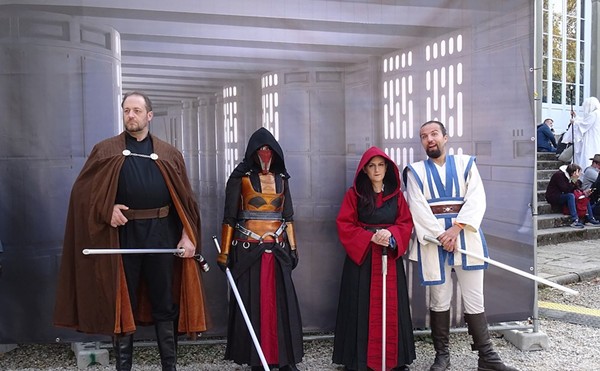Each month, Current food and wine critic Ron Bechtol assembles a wine-tasting panel composed of a chef or restaurant pro, a professional wine rep (sommelier, buyer, what have you), and a passionate amateur oenophile. Together they sample representatives of a wine category (country, region, grape, trend), ranking them according to taste, appearance, finish, price, label, and a few other factors. The Omniboire column, which appears online and in print the last Wednesday of every month, features every wine that earns at least 13 out of 20 points, but here we’ve collected top-scoring wines of the year to date, those that collectively garnered two or more corkscrews on the four-corkscrew chart. Text,
tallies, and faithful transcription of panel quotes by Bechtol.
January: Texas Cabs
The question on everybody’s lips — at least those with fairly loose lips — is this: Should Texas winemakers bother trying to produce cabernet sauvignon, or should they throw in the towel and go for grapes that have a better hot-weather track record? Rising to the challenge, Omniboire decided to take the beloved bull by the horns and stage a tasting of some of the state’s cabernet contenders. Due to a delivery glitch, some of the wines we had expected to taste didn’t arrive, but what we did taste was illuminating.
Our host for the event was chef and owner Brian West of Café Paladar, and we were joined by wine rep and all-around expert Ray Ayala of Republic National Distributors, and Tanji Patton, formerly of late-night news and a closet wine wonk all this time.
2005 Becker Vineyards Claret, Les Trois Dames
$15, Food-friendly with multi-layered dark fruit
An almost-Bordeaux blend of cabernet with merlot, malbec, cabernet franc, and just a soupçon of petite syrah.
“I really enjoyed it; it has dark fruits, fig … it would be great to drink with dinner,” said West.
“There’s a casual elegance about it,” offered Patton.
“It has nice layers … a lot of everything,” claimed Ayala — and this of a bottle that’s not Becker’s most prestigious cabernet-based wine.
2005 Llano Estacado Texas Cabernet Sauvignon
$13, Good varietal flavor and balance
The same High Plains vineyard also supplied fruit for Llano Estacado’s Cellar Reserve 2005 Newsom Vineyard Cabernet Sauvignon, and it was instructive to taste how different winemaking led to distinctive results from the same fruit. This wine rated a 16.5 and exhibited a more restrained nose than the Becker, but offered very appealing dark cherry with sage, cedar, and even graphite aromas and flavors, the package being marred only slightly by a somewhat harsh finish.
2003 Meeker Longhorn Cabernet Sauvignon, Mendocino County
$25, The ringer: well-integrated fruit with chocolate and coffee notes
Charlie Meeker, a man with deep Texas roots and a law degree from UT Austin, made this wine as an homage to a state where “everything’s big,” and the label screams Texas. (Yes, it’s longhorn-and-Texas-flag tacky.) Ayala enthused over its “beautiful nose and its wonderful, well-integrated oak and fruit,” theorizing it came from a warm vintage.
February:
Napa Valley Cabs
Few places in the New World rival California for cabernet sauvignon. Yes, Washington State is coming on strong, and, once you get past the phalanx of malbecs, Argentina has much to offer. But the Napa Valley is still the gold standard, especially to the fervent followers of Robert Parker and The Wine Spectator. Trouble is, many of these are “over-ripe, alcoholic, toasty-oak, food-unfriendly wines” — this in the words of Spectator’s own James Laube. Along with elevated alcohol and extreme extraction also come high prices, with cult cabernets reaching stratospheric levels.
Omniboire innocently wondered if there were any Napa cabs out there that did not require personal bottleguards — and that could be enjoyed with a simple steak. Setting a price range of around $20-50, prevailing upon friends from both Glazer’s and Republic distributing companies, plus a little personal wine-shop sleuthing resulted in nine contenders, including one ringer from another region renowned for its cabernets.
Josef Ignacz, sommelier-and-then-some at Silo 1604 was our host and a panelist. Keith Kuhn, accomplished chef and owner of Serendipity Wine Imports provided another polished palate, as did Gary Turner, wine consultant, collector, and taster-about-town.
2005 Caravan Napa Valley Cabernet Sauvignon
$36, Minty herbal notes with quince and caramel; long finish
Caravan is a second label of the much dearer Darioush, and “Its quality and intensity were close to the top for me,” offered Kuhn, who also found quince notes. Turner detected “a strong herbal presence — the nice side of that equation,” and Ignacz praised the “long-lasting flavor.”
2004 Buehler Napa Valley Cabernet Sauvignon
$21-$25, Roasted flavors with tobacco and mint; bright, long finish
Hot on Caravan’s heels was this unexpected winner. Kuhn found “lots of distinct flavor notes — including roasted green pepper,” and here is where he and Turner parted company. “It moved too far into the unroasted green pepper `spectrum` for me … the nose put me off,” he claimed. Omniboire liked its minty, dark-fruit qualities.
2004 Terra Valentine, Spring Mountain District, Cabernet Sauvignon
$39, Racy nose with dark fruit, sweet-tart flavors, forward tannins
Ignacz found “instant gratification” in our number-three wine. Kuhn found the wine to be “silky,” with lanolin in the nose and a “candied, sweet-tart quality” that was nevertheless balanced with acidity. “It’s too underwhelming for steak,” he opined, but could be enjoyed without food, while Turner called it an “easy-drinking, backyard-burger cab.”
2004 Napanook NapaValley Cabernet Sauvignon
$30-$35 Caramel and honey meet juicy, dark berries
A second label of the Christian Moueix Dominus estate, this Bordeaux-like blend of 83-percent cabernet with cabernet franc, merlot, and petit verdot, wasn’t universally loved (despite a big Parker score). “Just average to me,” thought Ignacz, while Kuhn said it had “poor cab qualities — though in a positive way” (perhaps a result of the blend), while Turner demurred, claiming that it was representative of cabernet, that it “loosened up and lingered” with time in the glass and that, “I’d put it to a steak.” Your scribe loved the “pretty” aromas and detected great balance and nice cherry-berry flavors.
2005 Faust Napa Valley Cabernet Sauvignon
$50-$53 Initially closed, well-balanced, lingering finish
The second label of Quintessa, one website has called this “The epitome of the style that has made Napa cabernet world renowned.” Yet it reminded Ignacz of Spain, and Kuhn claimed it was “technically correct” but “just didn’t shine.” Turner was more generous, saying, “I loved the flavor, the finish … `and the way` it washed across the mouth.” Its position in the blind-tasting lineup might have been partly to blame for lower scores, as it opened up beautifully from the re-tasted bottle a day later.
March: Oyster Whites
With the only criterion being to present wines that should be oyster-friendly, tastes and aromas were all over the map, making evaluation an exercise in focus and filtering.
Showing up for the challenge were James Martin, Sandbar’s engaging waiter, resident hyper palate (and personality) Joe Baker of Gabriel’s, and our very own editor, Elaine Wolff — who actually admits to liking whites as much as reds, thus making her an anomaly among my acquaintances.
2006 Craggy Range Te Muna Road Vineyard Martinborough Sauvignon Blanc
$24, Pure passion fruit and citrus with seamlessly integrated acidity
“It has a graceful texture `with` beautifully integrated acid and fruit — a pure-fruited wine,” said Baker. Omniboire loved its tropical nose and passion-fruit palate, while Madame Editor also loved the nose but found the wine a little sweet on the tongue. Martin accorded it a “tapered” finish.
2006 Koura Bay Atwatere Valley Marlborough Sauvignon Blanc (NZ)
$25, Quintessential New Zealand sauvignon blanc —
but with admirable restraint and finesse
This was a wine for sauvignon-blanc purists — those who get off on emphatic (but beautifully modulated) citrus. White flowers and sweet grass were detected by Wolff. It had “great purity and balance,” with notes of candied citron, according to Baker — who also dared to call it “tangy,” a word this writer is usually reluctant to use.
2006 Pighin Friuli Grave Pinot Grigio
$15-$16, White flowers on nose, persistent fruit and some creaminess on palate
“Burgundian style, with a range of yeasts,” claimed Martin; “a yeasty nose `plus` candied almonds and violets ... like a good Macon,” countered Baker. My “white flowers” were Wolff’s “waxy nose,” and while nobody thought this wine typical of pino grigios, we obviously all liked it.
2006 Pazo Señorans Rias Baixas Albariño
$15, Complex and challenging, but rewards with pungent flavors
“A slight funk, but OK for all that,” said Omniboire. Tweaking this comment, as editors are wont to do, Wolff found it to be “feral — like the bottom note of a perfume.” Martin, on the other hand, deemed the wine “playful and soft.” (Like playing with wolf cubs, perhaps?)
April: Aussie Shiraz
The Omniboire panel anticipated emerging from this tasting of Australian Shiraz — the “Rock of Gibraltar” of the Down Under wine industry — not only with purple teeth but with palates fatigued from alcohol and pummeled by ripe, dark fruit. The tree-shaded patio of Bin 555 was an ideal setting for the sampling of big, ballsy wines. They looked dark and intimidating arrayed in the 10 glasses before us. The Bin’s owner and chef, Jason Dady, and his general manager and wine guy, Mark McMurray, were ready to do battle. So were David Verheyen of Glazer’s Distributing and plastic surgeon and wine aficionada Catherine Milbourn.
2005 Rusden Stockade Barossa Valley
$18, Fruit-pit qualities with chocolate and dark berry
If a “bloody nose” were ever to be a good thing it is to be found in this top-scoring wine, according to Verheyen, who also found an “explosive palate.”
“Wow, this is a good, good glass of wine,” enthused Milbourn, and she was seconded by McMurray, who found “bold aromas and flavors” — though not a very long finish. Keeping things honest, Dady demurred, finding the wine “astringent” and difficult to drink in any quantity.
2006 Tapestry McLaren Vale Bakers Gully Vineyard Shiraz
$14, Berry and bramble on nose, red fruit on palate
“Bubble gum,” said Dady. “Big League Chew,” offered Mc Murray. “Leather lite,” ventured Omniboire. “Juicy,” thought Verheyen — with a “dark and brambly nose and a very long finish.”
“A nice, all-around wine,” concluded McMurray.
2005 Wolf Blass President’s Selection South Australia Shiraz
$19, Initially herbal, then cherry-currant flavors
“Well-rounded, and great with a grilled lamb chop,” suggested Dady. “Herbs and mint … and then the good tar,” offered Milbourn.
2005 Jacob’s Creek Reserve South Australia Shiraz
$14.50, Intense nose, dark and deep red fruits
“It has an herbal nose … more like a real syrah,” commented Verheyen. “The taste isn’t up to the nose,” offered McMurray, “yet I could sit and drink it.”
“It’s great with the manchego” (one of the many tasting snacks that had come out of the Bin’s kitchen) observed Dady. “I keep going back to this one.”
________________________________________________
Exceptional, snap it up
Extremely good, seek it out
Good, some outstanding qualities


















